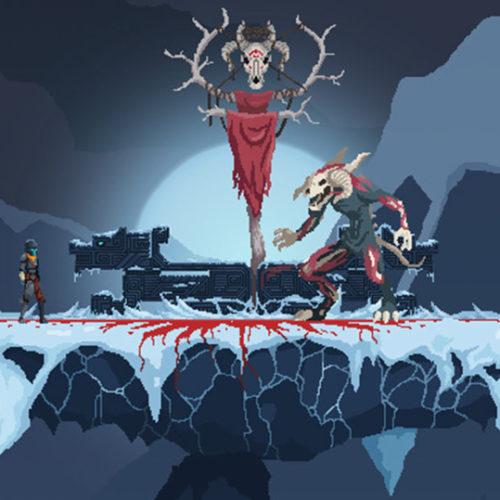Prepare to die.
Death is at the heart of any Souls’ game. It is therefore apt that developer White Rabbit decided to title their own 2D Souls’ tribute Death’s Gambit, and feature the scythe-bearing entity as one of the first characters the player encounters.
Another 2D platform game inspired by From Software’s Dark Souls series, Death’s Gambit immediately stands out from the crowd courtesy of its eye-catching visual style and excellent soundtrack. That said, at times the verisimilitude – particularly in terms of the character selection and inventory management menus – is so overt, one can’t help but question whether Death’s Gambit is White Rabbit’s love letter to Souls, or whether such similarities are merely a case of creative laziness. It is a line upon which this game delicately tiptoes throughout.

MSRP: $19.99
Platforms: PS4 (reviewed), PC
Gothic style.
Death’s Gambit looks great. I would be remiss if I didn’t confess the following: I am someone who is not particularly enamoured by contemporary pixel-art games. However, I can’t deny the impressive visual presentation on offer here. Death’s Gambit has a dark, gothic vibe with some colourful flourishes in all the right places. The animation is crisp and the design of the characters, bosses and environments is really quite striking.
The game’s visuals are backed up by a wonderful soundtrack. The score was the first thing that actually captured my attention when playing this game, and really helps set the tone.
Pace yourself.
As with any Souls game, Death’s Gambit presents the player with a hefty challenge in terms of difficulty. Phoenix Plumes function as Estus flasks, albeit the player loses a Plume upon death and must pay shards (souls) at save points (Idols) to buy them back. Shards can also be spent on levelling up and when players reach the Central Sanctuary area, they will encounter characters who will sell additional items and abilities.
Like games of this nature, patience is required for meaningful progression and players should consider an alternative course if one route is blocked by a particularly challenging foe. When it comes to combat, Death’s Gambit places a heavy emphasis on stamina: it’s extremely limited and players must approach each fight with a significant amount of restraint. It’s a mechanic that does become cumbersome (more on that below), particularly because it contributes to imbuing combat with an unnecessarily weighty feel.
What happens next?
Death’s Gambit is not without some frustrations. It is hampered by a manoeuvrability design that isn’t particularly responsive. Whilst I have no great issue with the challenging stamina system conceptually, in practice the hit recognition feels wildly inconsistent – at which points, stamina becomes an unwelcome obstacle to overcome rather than an appropriate balancing mechanism. Overall, combat felt incredibly slow and restrictive rather than fluid and natural. Similarly, a lack of variety in weapon type also contributes to a sense of repetitiveness across enemy encounters.

The game is also small – in length and scope. Death’s Gambit does a good job of effectively replicating the Dark Souls’ format that encourages trial and (lots of) error until the player finally succeeds. However, exploration and progress are actually quite constrained due to the limited span of each area. There simply isn’t far to go until you reach a boss. Whilst Death’s Gambit certainly isn’t misrepresenting itself as some sort of grand epic, it still feels quite restrictive as the trial and error mechanic becomes more of a grind than maybe it should for a Souls game.
Conclusion.
Death’s Gambit has style, personality and some potentially innovative ideas that takes it well beyond a mere copy-cat Souls game. Unfortunately, the game’s inner demons quickly reduce things to a repetitive grind. That grind doesn’t always feel like it’s worth the time investment, despite the enchanting visual glamour. It’s worth a look because of its unique style, which really is a cut above the rest, and it is clear that White Rabbit have had a good crack at producing a game that tries to be creative with an established formula. However, be prepared for a journey that’s a bit of a slog in more ways than one.
Review copy of game provided by publisher.
